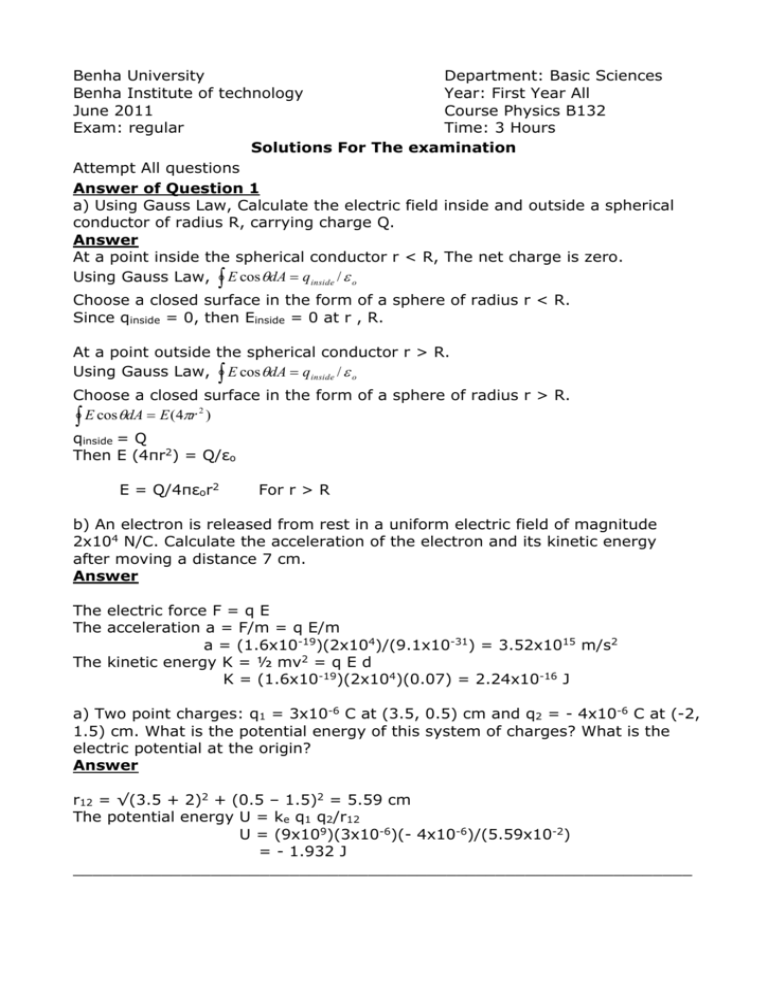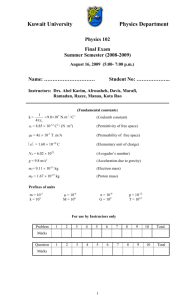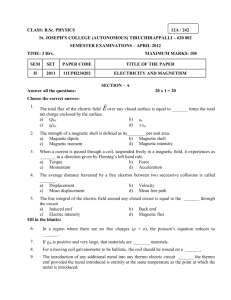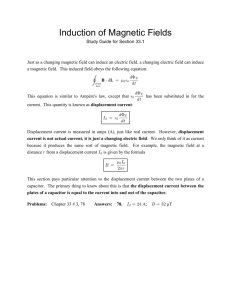Benha University
advertisement

Benha University Department: Basic Sciences Benha Institute of technology Year: First Year All June 2011 Course Physics B132 Exam: regular Time: 3 Hours Solutions For The examination Attempt All questions Answer of Question 1 a) Using Gauss Law, Calculate the electric field inside and outside a spherical conductor of radius R, carrying charge Q. Answer At a point inside the spherical conductor r < R, The net charge is zero. Using Gauss Law, E cos dA qinside / o Choose a closed surface in the form of a sphere of radius r < R. Since qinside = 0, then Einside = 0 at r , R. At a point outside the spherical conductor r > R. Using Gauss Law, E cos dA qinside / o Choose a closed surface in the form of a sphere of radius r > R. 2 E cosdA E (4r ) qinside = Q Then E (4πr2) = Q/εo E = Q/4πεor2 For r > R b) An electron is released from rest in a uniform electric field of magnitude 2x104 N/C. Calculate the acceleration of the electron and its kinetic energy after moving a distance 7 cm. Answer The electric force F = q E The acceleration a = F/m = q E/m a = (1.6x10-19)(2x104)/(9.1x10-31) = 3.52x1015 m/s2 The kinetic energy K = ½ mv2 = q E d K = (1.6x10-19)(2x104)(0.07) = 2.24x10-16 J a) Two point charges: q1 = 3x10-6 C at (3.5, 0.5) cm and q2 = - 4x10-6 C at (-2, 1.5) cm. What is the potential energy of this system of charges? What is the electric potential at the origin? Answer r12 = √(3.5 + 2)2 + (0.5 – 1.5)2 = 5.59 cm The potential energy U = ke q1 q2/r12 U = (9x109)(3x10-6)(- 4x10-6)/(5.59x10-2) = - 1.932 J _______________________________________________________________ Answer of Question 2 a) Derive an expression for the energy stored in a capacitor. Then find the electric energy density. Answer The capacitor is connected in a charging circuit where the charge increases with time from 0 to a final charge Q. At a time t, the charge in the capacitor is q(t) and the potential across the capacitor is V = q/C. After a time dt, the charge will increase by dq. The work done to increase this charge dq is dW = V dq = q/C dq The work done to charge the capacitor from 0 to Q is Q Q2 W = dW (q / C )dq 2C 0 This work is stored as potential energy U in the capacitor. Then, U = W = Q2/2C = ½ CV2 as Q = CV The electric energy density is the electric energy per unit volume. Consider a parallel plate capacitor with capacitance C = εoA/d. The potential across the capacitor is V = Ed. The electric energy stored in the capacitor is U = ½ CV2 = ½ (εoA/d)(E2d2) = ½ εo E2 Ad The electric energy density uE = U/volume = ½ εo E2. b) A current of 17 A is maintained in a single circular loop with circumference of 2 m. A magnetic field of 0.800 T is directed parallel to the plane of the loop. (a) Calculate the magnetic moment of the loop. (b) What is the magnitude of the torque exerted on the loop by the magnetic field? Answer a) Circumference = 2πr =2 The radius r = 2/2π = 0.318 m Area of the loop A = πr2= π(0.318)2 = 0.318 m2 The magnetic moment μ = NIA = (1)(17x10-2)(0.318) = 5.41x10-3 Am2 b) The torque τ = μ B sinθ = (5.41x10-3)(0.8)(sin90) = 4.33x10-3 Nm The torque is directed perpendicular to both μ and B according to R. H. R. _______________________________________________________________ Answer to Question 3 a) An electron with velocity 5x106 m/s moves in a circle perpendicular to a uniform magnetic field. The orbit radius is 25 cm. Calculate (i) the magnetic field, and (ii) the frequency of revolution. Answer (i) The equation of motion is qvB = mv2/r The radius of the circular path is r = mv/qB The magnetic field B = mv/qr = (9.1x10 31 )(5 x10 6 ) 1.1375 x10 4 T (1.6 x10 19 )(0.25) (ii) The period T = 2πr/v =2πm/qB The frequency f = 1/T = qB/2πm = (1.6 x10 19 )(1.1375 x10 4 ) = 3.18x106 Hz. (2 )(9.1x10 31 ) b) A cylindrical conductor of radius R = 2.50 cm carries a current of I = 2.50 A along its length; the current is uniformly distributed throughout the crosssection of the conductor. (a) Calculate the magnetic field midway along the radius of the wire (that is, r = R/2). (b) Find the distance beyond the surface of the conductor at which the magnitude of the magnetic field has the same value as the magnitude of the field at r = R/2. Answer (a) At r = R/2, the point is inside the conductor. The magnetic field B = μoIr/2πR2 B = μoI(R/2)/2πR2 = μoI/4πR (4x10 7 )( 2.5) B= = 1x10-5 T (4 )( 2.5 x10 2 ) (b) The magnetic field outside the conductor is B = μoI/2πr (4x10 7 )( 2.5) = 5x10-2 m 5 cm. 5 (2 )(1x10 ) _______________________________________________________________ Answer to Question 4 a) Using Faraday’s law, derive an expression for the induced emf in a rotating coil with angular velocity ω in a uniform magnetic field B. The coil has N turns and area A. Answer The distance r = μoI/2πB = The magnetic flux through the coil is NФB = N B A cos θ The angle θ = ωt Then, the magnetic flux through the coil is NФB = N B A cos ωt Using Faraday’s law, the induced emf is Ε = - d(NФB)/dt = N B A ω sin ωt b) an inductor in the form of a solenoid contains 420 turns, is 16 cm in length, and has a cross-sectional area of 3.00 cm2. Find the inductance of the coil. What uniform rate of decrease of current through the inductor induces an emf of 175 μV? Answer The inductance L = μo n2 l A = μo N2 A/l (4x10 7 )( 420) 2 (3) L= = 4.156 H 0.16 The induced emf ε = - L dI/dt The rate of decrease of current dI/dt = - ε/L = - 175x10-6/4.156 = 4.21x10-5 A/s _______________________________________________________________ Answer to Question 5 Choose the correct answer justifying your results. 1. A 3.5-cm radius hemisphere contains a total charge of 6.6 × 10−7 C. The flux through the rounded portion of the surface is 9.8 × 104 N · m2 /C. The flux through the flat base is ………... (a) +2.3x104 Nm2/C (b) - 2.3x104 Nm2/C (c) – 9.8x104 Nm2/C (d) zero 2. If the electric field is in the positive y direction, then, the potential of the point (1, 5) is ………the potential of the point (-1,5). (a) equal to the negative of (b) Less than (c) more than (d) equal to 3. When the space between the plates of a capacitor is filled with a dielectric material, a. the capacitance will increase and the potential difference will decrease. b. both the capacitance and the potential difference will decrease. c. both the capacitance and the potential difference will increase. d. the capacitance will decrease and the potential difference will increase. 4. What is the drift velocity of electrons in a copper wire carrying current of 5 A if the wire has electron density of 8.4x1022 electrons/ cm3. (a) 3 cm/s (b) 9 cm/s (c) 6.82 cm/s (d) none 5. The time of one revolution of a charged particle moving in a magnetic field is ………… ……… the magnetic field. a. is directly proportional to the square of b. is inversely proportional to c. does not depend on d. is directly proportional to 6. The magnetic field inside a long solenoid is …………. the axis of the solenoid. a. Parallel to b. 135˚ with c. normal to d. 45˚ with







